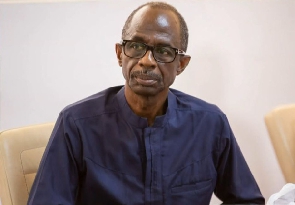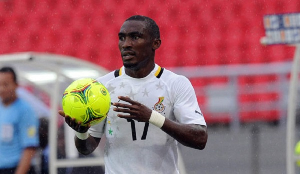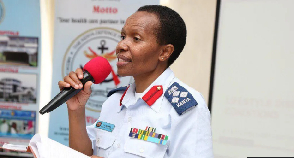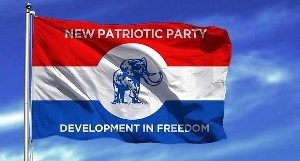Opinions of Tuesday, 17 April 2007
Columnist: Mansah, Adwowa
Aspects of Self-mobilization during the Nkrumah Era
One of Nkrumah’s greatest accomplishments was the mobilization of the country’s resources – both human and natural resources. In this article I well dwell on the human resource part of the mobilization Nkrumah carried out from 1951 till he was overthrown by self-seeking narrow-minded soldiers and the police.
Let me digress a little bit to expatiate on why I call the 1966 coup leaders and their key advisers (Busia – chief political adviser, and E. N. Omaboe aka Nana Ampem Wereko – chief economic adviser) self-seeking and narrow-minded. Afrifa single-handedly destroyed the country’s railway system when his fleet of articulators started carting cocoa and timber form the rural areas directly to the ports instead of going to the rail nodes that had been created for hauling bulk freight to the ports. Afrifa also appropriated to himself portions of the Ejura State Farms as his personal property which he named as Okatakyie Farms. He turned his village Krobo, near Asante Mampong into estate houses for his people for which they not a pesewa. Afrifa did all these things in the three years of the NLC rule. This is not mention the bribery trap General Ankrah was caught in by Arthur Nzeribe. General Ankrah acquired his on the Ring Road opposite Broadcasting House during his short tenure as Chairman of NLC. The reflecting decals all motor vehicles were required to display at the back of each motor vehicle was a requirement that was designed to benefit Deku and Harley. These reflecting decals were sold by one company owned by Deku and Harley, members of the NLC.
Let me now return to Nkrumah’s mobilization programme. On the human resource front he unleashed the self-mobilization potential of the Ghanaian to address the myriad of problems facing the country: unemployment, lack of schools, roads, healthcare centres, water supply, housing, and industries.
Nkrumah tackled the problem of self-doubt that had been planted in us through years of preaching and teachings that saw the “evil” in everything indigenous. He appropriated indigenous symbols and turned them into national symbols – see “Political symbols of modern Ghana” at http://www.marshall.edu/akanart/akanpolbeliefs.html/. Kofi Antubam, then art tutor at Achimota School, was given the responsibility in 1959 to design various works in line with the nationalist fervor prevailing in the country at the time. He designed the doors to the building of Parliament, and he also created three seats of government that were inspired by "traditional" Ghanaian shapes and symbolism. One of these seats is shaped like the throne of a chief and has been richly decorated with adinkra symbols. Kofi Antubam also created the state mace (now used by the Speaker of the Parliament) and the Presidential State Sword (Oman Akofenata) with which the President takes the oath of office and is crried in a procession in front of the President when he goes to address the Parliament.
Nkrumah and his ministers popularized kente and fugu of the north by wearing these clothes at important state functions. He conspicuously took the kente to the world stage by having it hung in the halls of the United Nations declaring, Tikoro nko Agyina (or Obaakofoo mmu man), to emphasize the neutrality stance of the non-aligned states (the non-aligned movement or the so-called third world) in the super-power geopolitics of those times. The kente symbolized African Pride and helped to tackle the psychological emasculation of the Ghanaian and African Personality. Kente has become an international symbols that Africans wear with pride.
That mobilization process to give self-pride to the Ghanaian that Nkrumah launched sent the mainstream religious leaders in Ghana reeling. For example when he formed the Young Pioneer Movement to instill this self-pride and African Personality in the country’s young people, the Catholic Church, Methodist Church and the Presbyterian Church, for example, countered by forming the Catholic Youth Organization, Methodist Youth Fellowship, Boys and Girls Brigade, and the Presbyterian Youth Fellowship. These Churches had been in existence in Ghana for decades without these youth organizations, but as soon as Young Pioneer Movement was formed to instill national integration, a sense of national identity and cultural pride in our young people, the Churches countered with their own youth organizations to undermine the viability of the Young Pioneer Movement. The Churches opposed the pledge of allegiance and the raising of the Ghana Flag in the schools. It was for this opposition to the pledge of allegiance that the British-born head of the Anglican Church, Roseavere was deported from Ghana. Come to think of it, these Churches saw nothing wrong with the Boys and Girls Scout Movement that Baden Powell had fashioned out of our “asafo akwansrafo” scout system. As matter of fact, the various youth organizations these Churches formed as a counter to the Young Pioneer Movement, were fashioned after the Scout Movement because these Churches thought they were instilling the teachings of something foreign and international in our children.
Another aspect of Nkrumah’s mobilization of the country’s human resource took the form of “communal labour.” Admittedly, Nkrumah did not invent “communal labour” in Ghana. He rather took it to higher levels by calling on the people to build schools, health centres, roads, markets, and several other social projects. Wherever, the community mobilized to build such projects the government came in with assistance in the form of building materials, recognition of these projects as “government assisted” (any one remembers “government assisted secondary schools?”). This mobilization process set in chain extensive infrastructure build up to compensate for the neglect by the colonial administration. Many feeder roads, public toilets, and health centres in the country were started through such “communal labour” projects.
It was this communal labour spirit that influenced Gordon Green, a British teacher at Mfantsipim Secondary School, to form the Voluntary Workcamps Association, VOLU in 1956. VOLU became the vehicle through which the leisure hours of students (secondary schools, teacher training colleges, technical and polytechnic schools, and universities) were mobilized for communal projects. The government, through the Department of Social Welfare and Community Development and later, Builders Brigade, provided technical and material support (e.g., masons and carpenters and tools) for some of these communal projects. The railways and State Transport Corporation chipped in their support by providing concession tickets to student volunteers traveling to and from work-camps organized by VOLU. The Tsito Adult Residential Training Centre in the Volta Region and the public bathrooms at Anomabo in the Central Region are examples of the initial projects on which VOLU student volunteers and artisans from the Department of Social Welfare and Community Development helped. The latter creation of the Builder’s Brigade (set up with the assistance of Israel), as an example of human capital formation through on-the-job training, served as the base to train skilled artisans such as carpenters and masons, for example, who were sent out to help out on some of the “communal labour” projects.
It was the same communal labour spirit of self-mobilization that spurred VOLU member students at Komenda College to initiate what later became a national mobilization exercise. When Acheampong declared "Yentua in 1972, it energized the youth, particularly students to self-mobilize to harvest sugarcane for the sugar factories at Komenda and Asutuare. The first sugarcane harvesting was initiated by VOLU students at Komenda College. When UCC were infomed by word of mouth, Can Tamakloe, then NUGs president, visited Komenda College on the eve of the first sugarcane harvesting day. The Komenda College VOLU members initiated the sugarcane harvesting as an expression of their displeasure at Busia's earlier call for "Walk Against Hunger" in 1970. The students felt that instead of being asked to walk 6 miles from Komenda to Kisi Junction and back, their energies could have been mobilized to grow food to feed themselves with. "Walking Against Hunger" rather made them hungry.
On that first harvesting day, Col. Bernasko visited and participated in the harvesting. Participants in this first harvesting day were solely all the Komenda College students and a bus load of UCC students. Subsequent weekends saw all Cape Coast secondary schools and training colleges and UCC students and later on students from Western Region schools at Komenda. Then NUGs mobilised all Accra schools and colleges for Asutuare. This snowballed into a national mobilisation process. This started in June of 1972.
Spearheaded by some students from STC, Winneba and Legon - Dawhenya irrigation project was undertaken as a follow-up to the sugarcane harvesting. Subsequent student mobilisation exercises - e.g., carrying cocoa following Dec 31st - took their cue from this 1972 national endeavour.
Human resource mobilization through VOLU did not only put the students to communal work, it also served as a vehicle for the young students to see and participate in solving some of the problems of society. It also gave the young students the opportunity to get their hands “dirty” in building schools, bridges, roads, etc for the community. More importantly, VOLU served to breakdown social class and ethnic/tribal barriers. It gave the volunteers the opportunity to “see” how the other half lived in the country. The spirit of self-help and communal labour is still an important factor in the Ghanaian culture. The Busia-era National Service Corps, the Rawlings-era National Youth Corps, and the present Kufuor administration’s National Youth Employment Service, and the National Service Scheme for tertiary students have all been fashioned after the VOLU’s example.
The education front became the centre of the human resource mobilization process that the Nkrumah administration unleashed in the country. The formal school and non-formal organizations were mobilized for human capital formation through general education and specific skill training through on-the-job training projects. On the formal school side, Nkrumah urged communities to self-mobilize to build schools to which he would send trained teachers. The outcome of this mobilization on the education front is quantified by the following numbers: In 1951 when Nkrumah assumed office there were 1,083 primary schools with an enrolment of 153,360 pupils; 539 middle schools with and enrolment of 66,175 pupils; and 13 secondary schools with an enrolment of 5,033 students. In 1966, when Nkrumah was overthrown, there were 8,144 primary schools with an enrolment of 1, 137,495 pupils; 2,277 middle schools with an enrolment of 267,434 pupils, and 105 secondary schools with an enrolment of 42,111 students. This accelerated growth of elementary and secondary education laid the foundation for the expansion of tertiary education in the country. The one university in 1951 with an enrolment of 208 students became three universities in 1966 with an enrolment of 4,291 students. These numbers do not include the hundreds of people sent abroad at the government’s expense for refresher courses and other forms of education and training. To encourage research and development and scholarship the government established the National Research Council (NRC) in 1958. The NRC was later turned into the Council for Scientific and Industrial Research). The Ghana Academy of Learning (now the Ghana Academy of Arts and Sciences) was set up by the government in 1959. The Encyclopaedia Africana Project was launched in 1962 under the sponsorship of the Ghana Academy of Sciences.
The Mobile Cinema Unit (Aban Sene) of the Information Service Department served as a very powerful tool for political socialization in the effort to forge national integration, a sense of national orientation, national identity, and national pride. Prior to 1951, Ghana had existed as the Gold Coast Colony (the present day Western, Central, Eastern and Greater Accra Regions), Ashanti (present day Ashanti and Brong Ahafo Regions), Trans-Volta Togo (present day Volta Region), and Northern Territories (present day Northern, Upper East and Upper West Regions). People began to describe themselves as Ghanaians rather than Asante, Kwahu, Anlo, Frafra or Bono. It was this effort to forge a national identity and national integration that the Danquah-Busia-NPP tradition resisted by calling for secession with “Mate me ho” slogan. People of this self-centred tradition now charge others with “tribalism!”
The Mobile Cinema Unit also served to encourage people to undertake more self-help projects. One popular documentary shown by the Aban Sene to encourage people to promote more self-help projects was titled “improvement comes to Kojokrom.” The puppet show (kohinko) which preceded the documentary shows was very popular with children.
This is a brief account of some aspect of the mobilization initiative of Kwame Nkrumah. I hope this brief account will help us to understand the strengths of his plans and where he went wrong in order to learn lessons for formulating for implementation a stronger and more dynamic programmes for the struggle to free Ghana from continued external domination.













